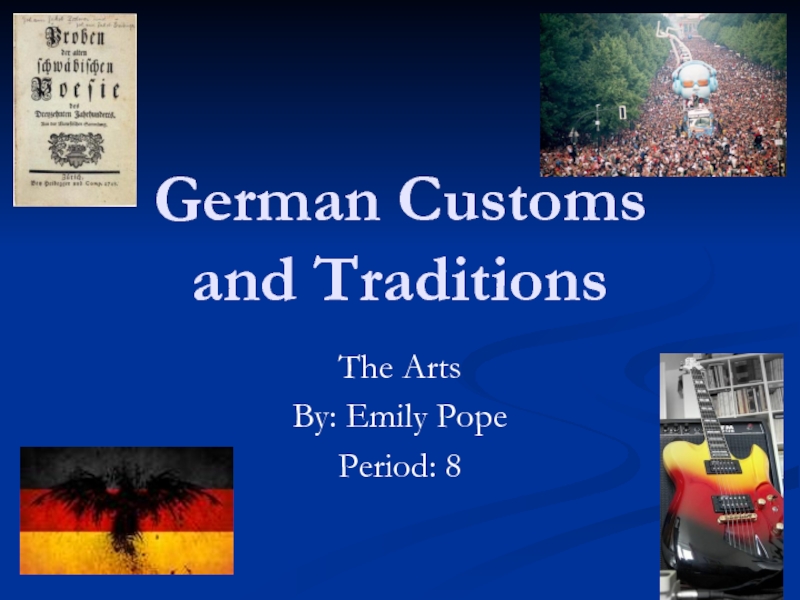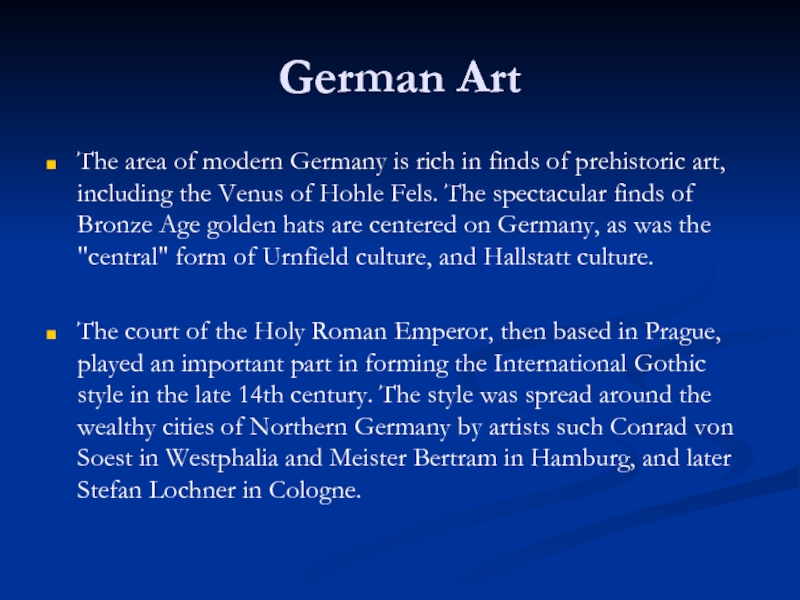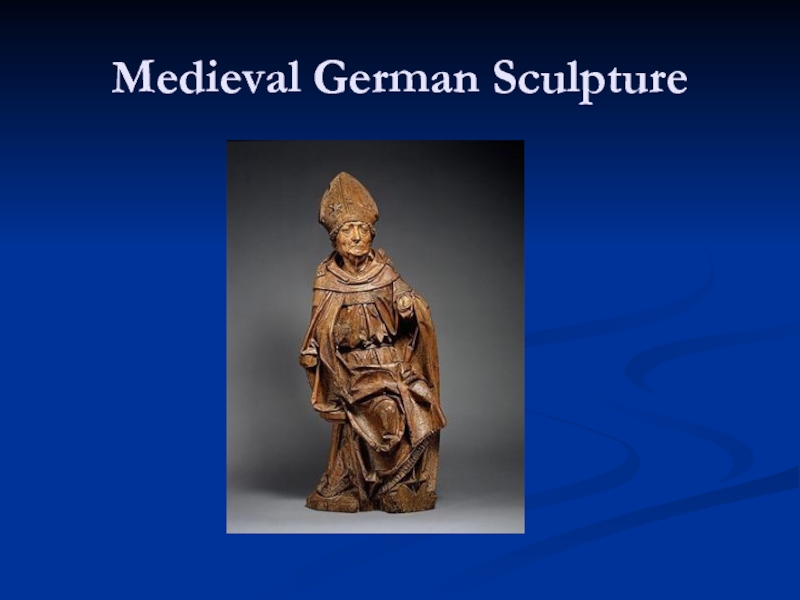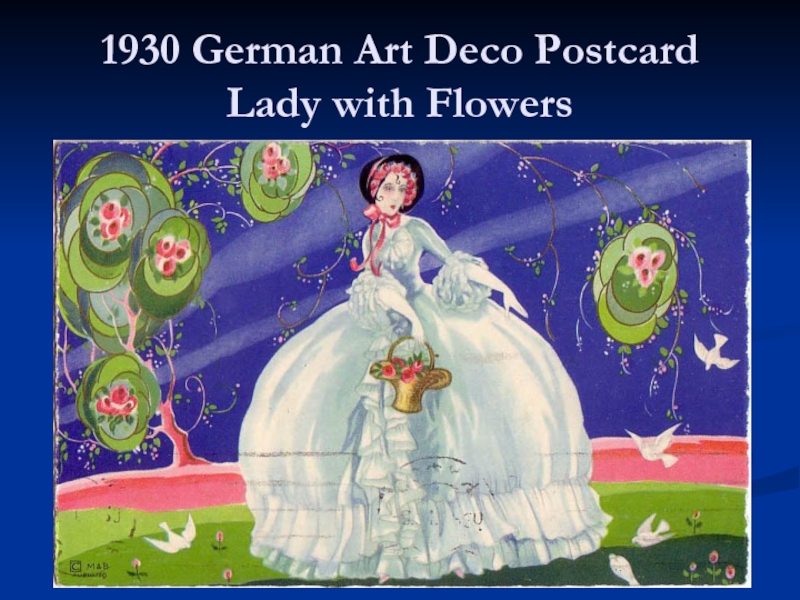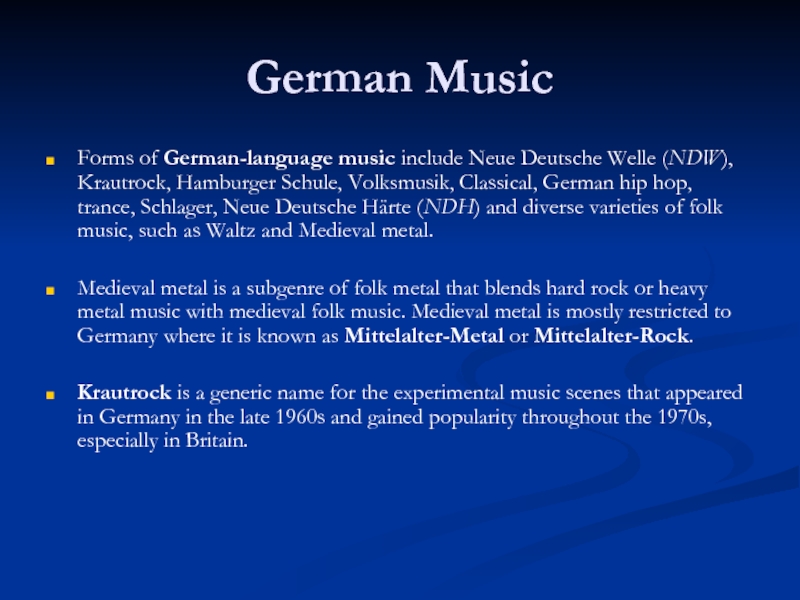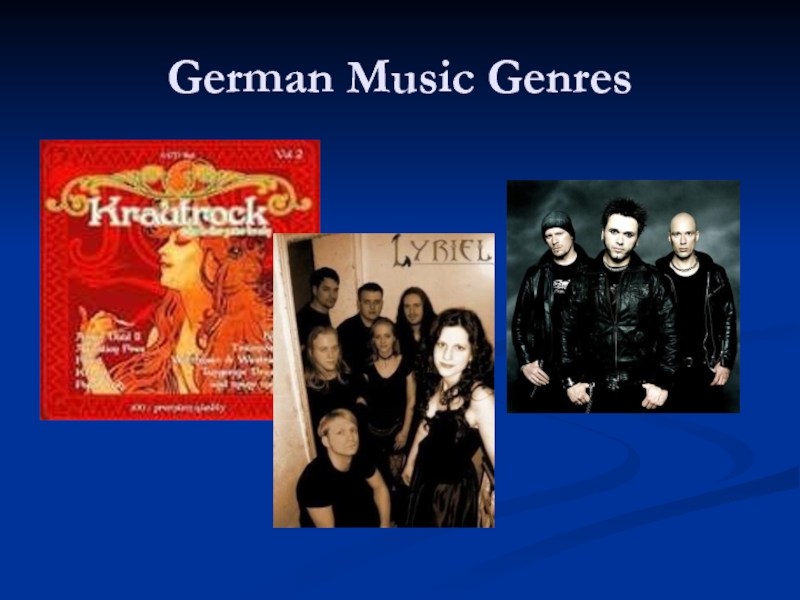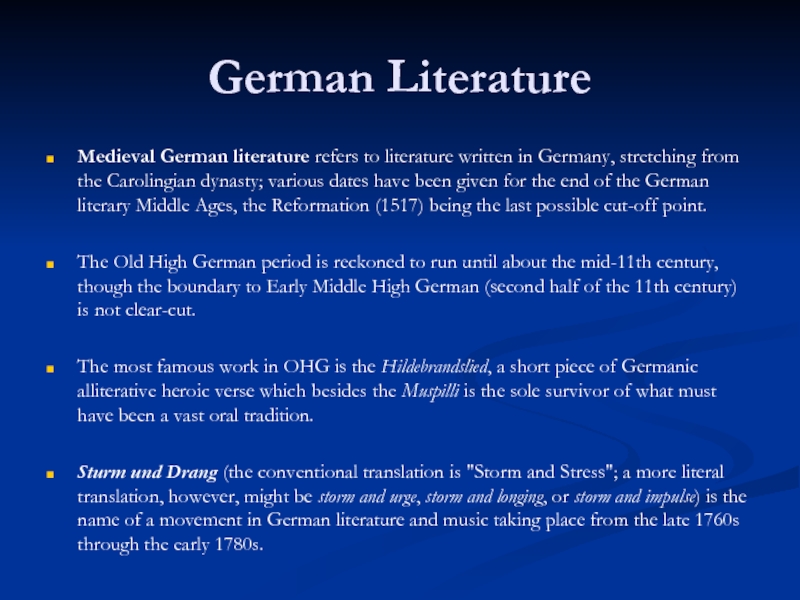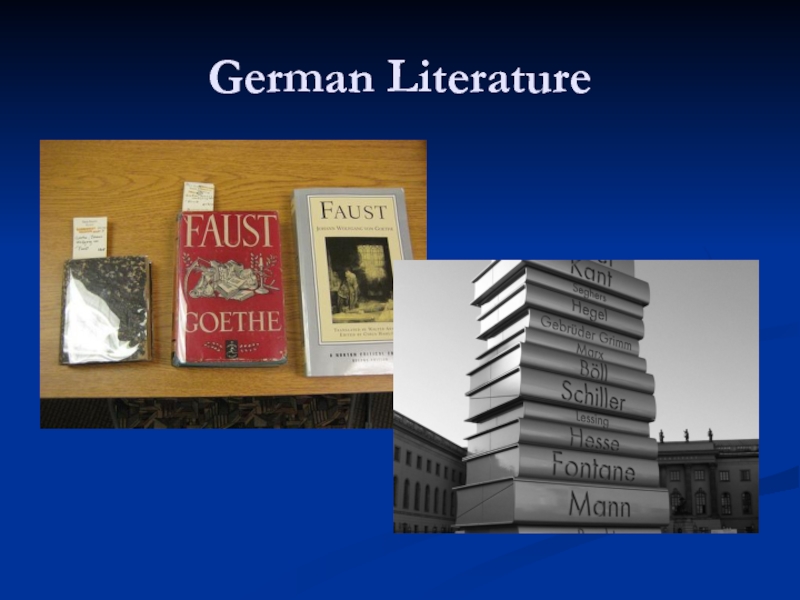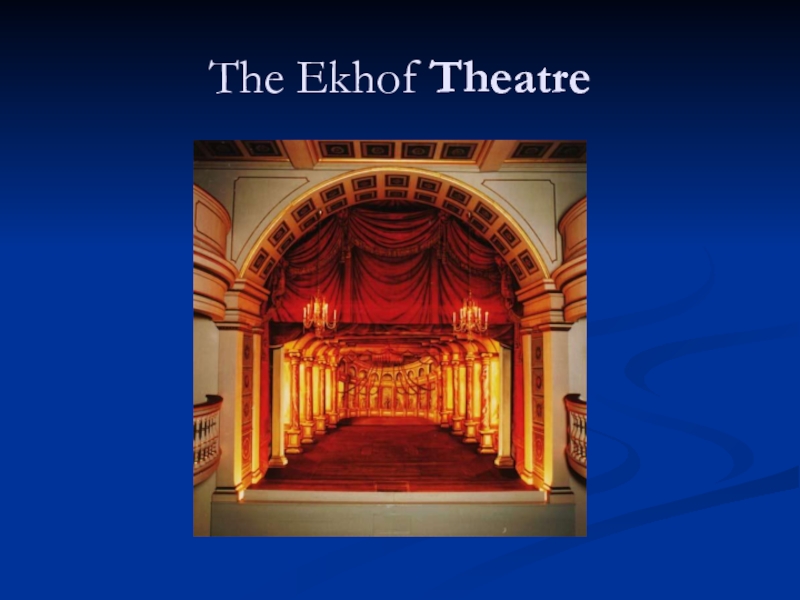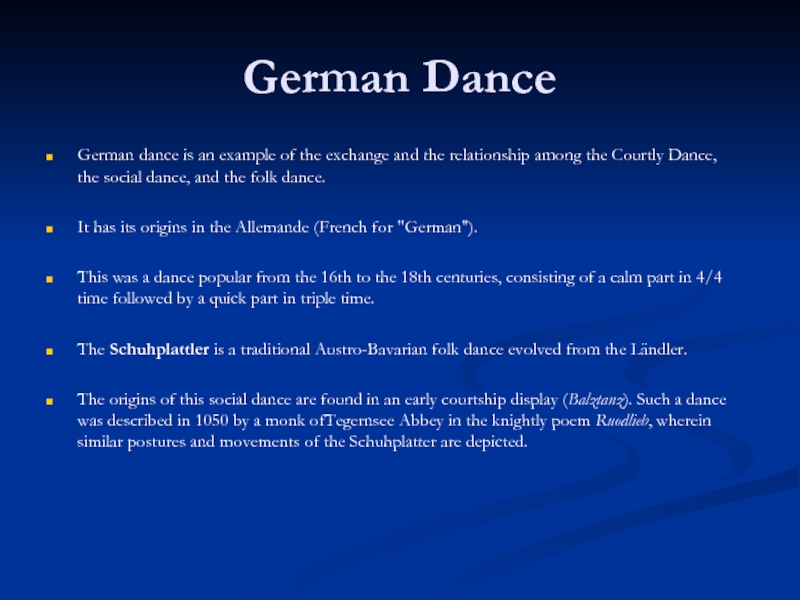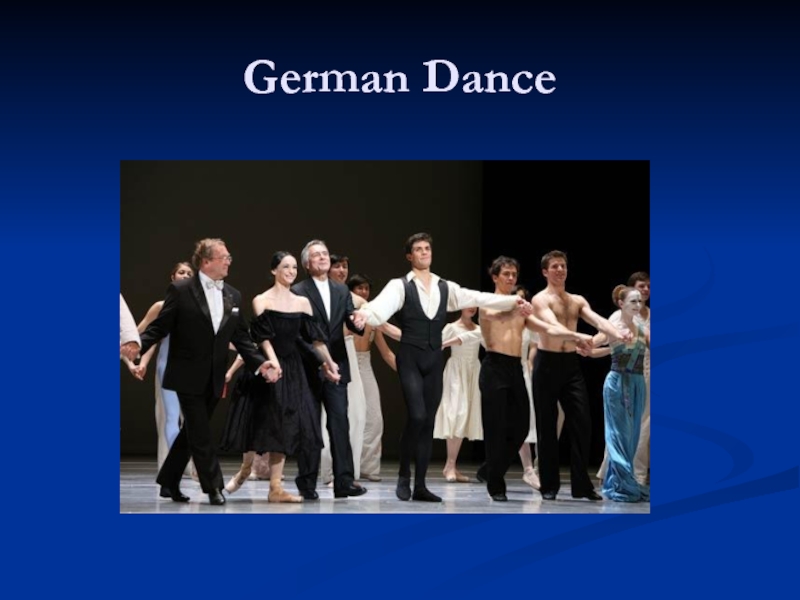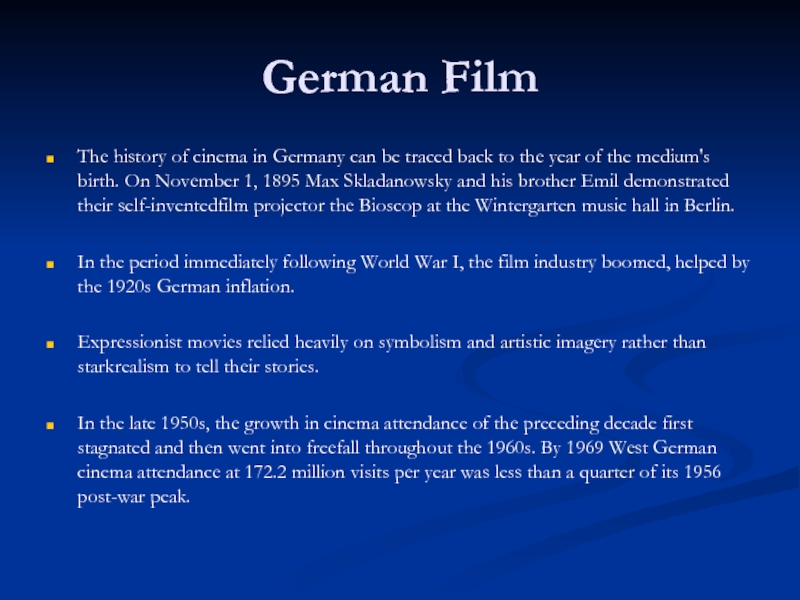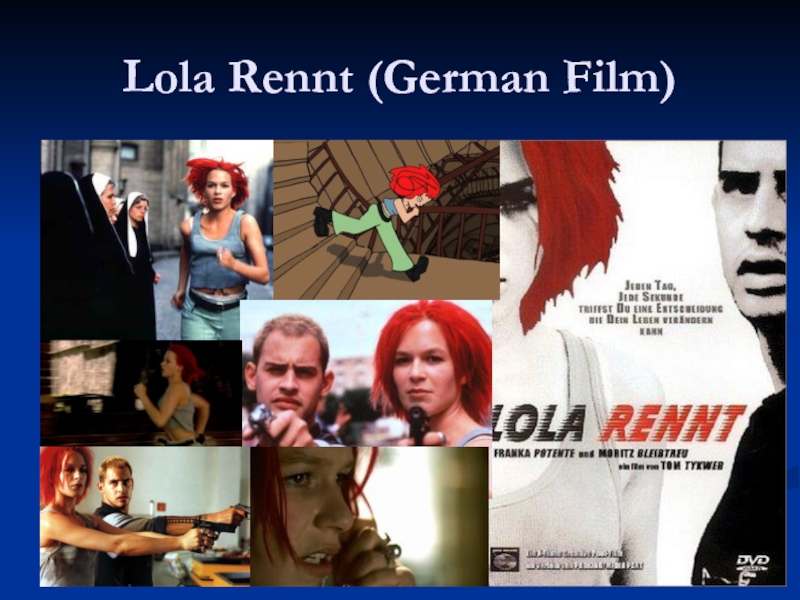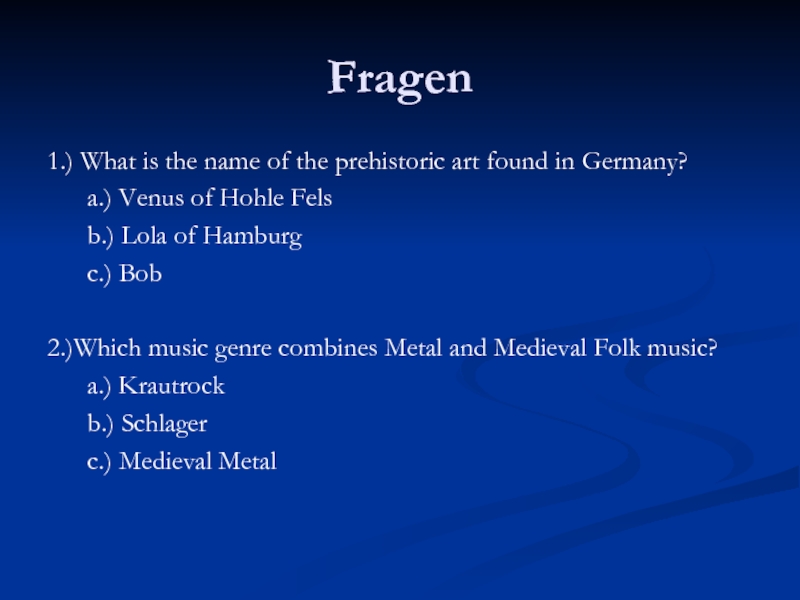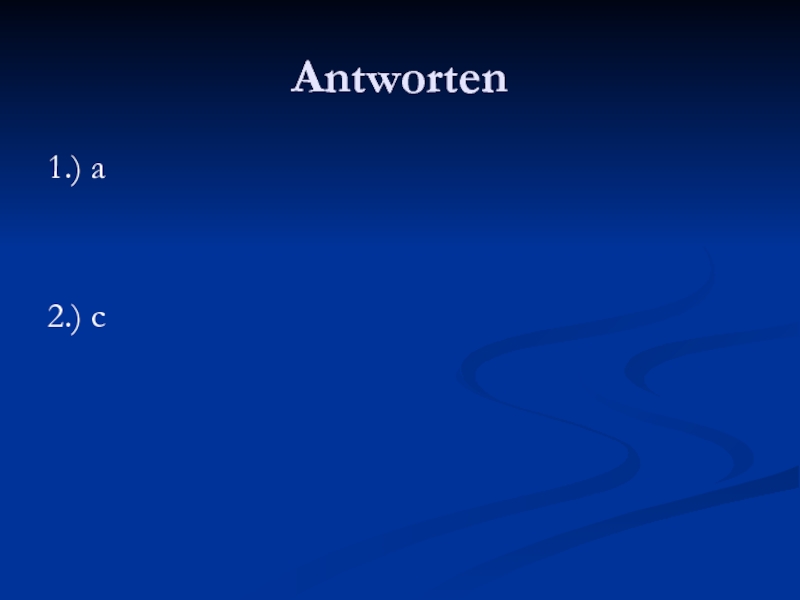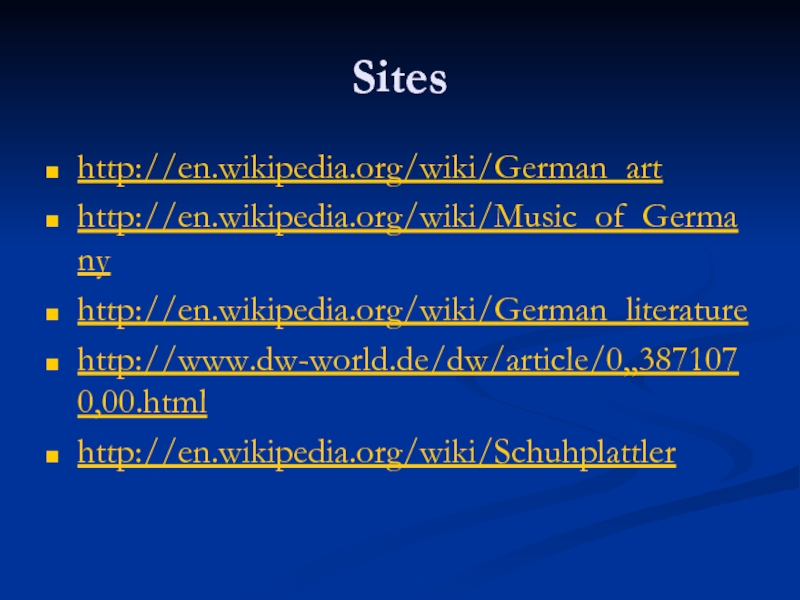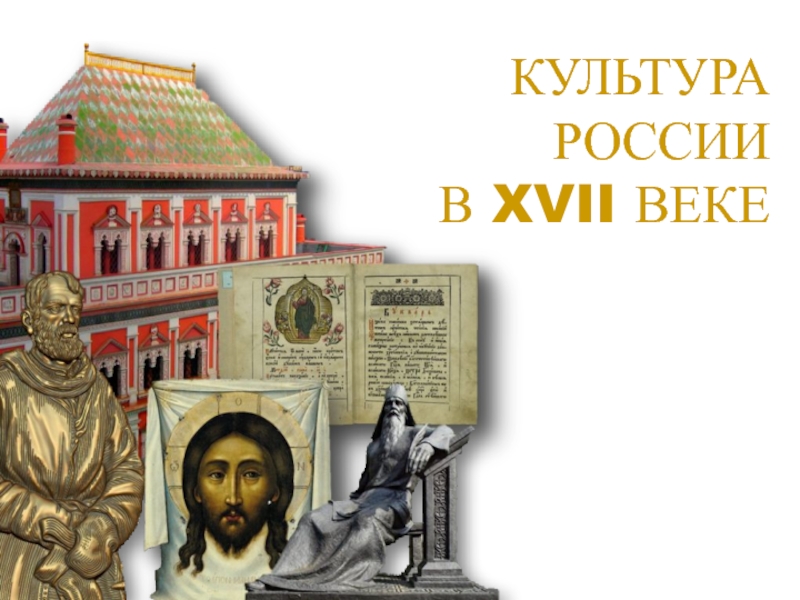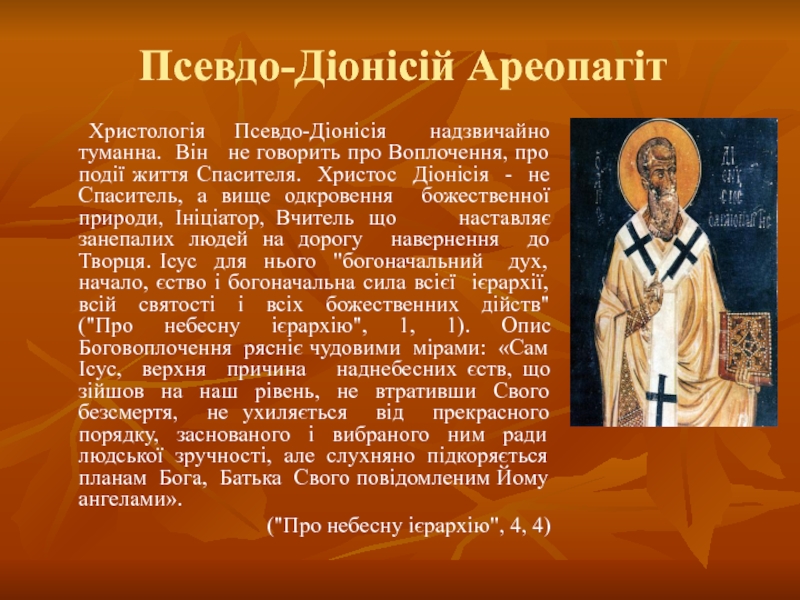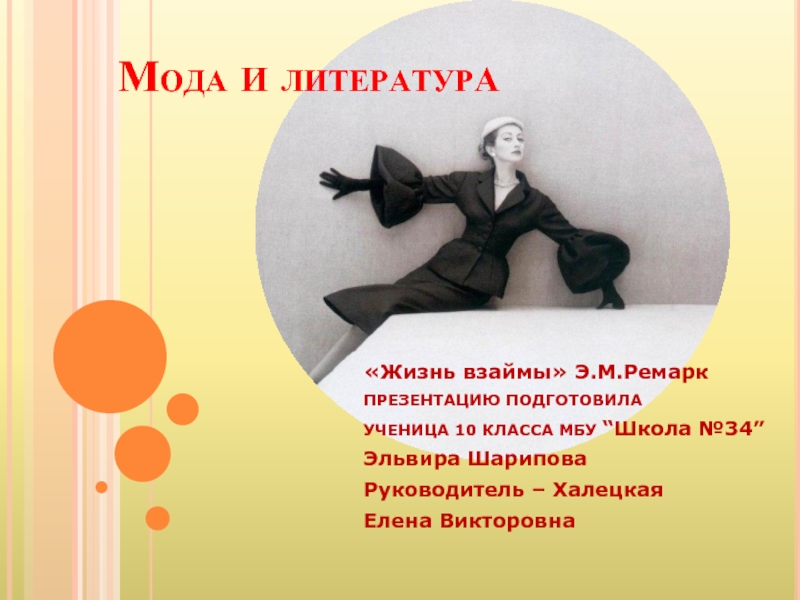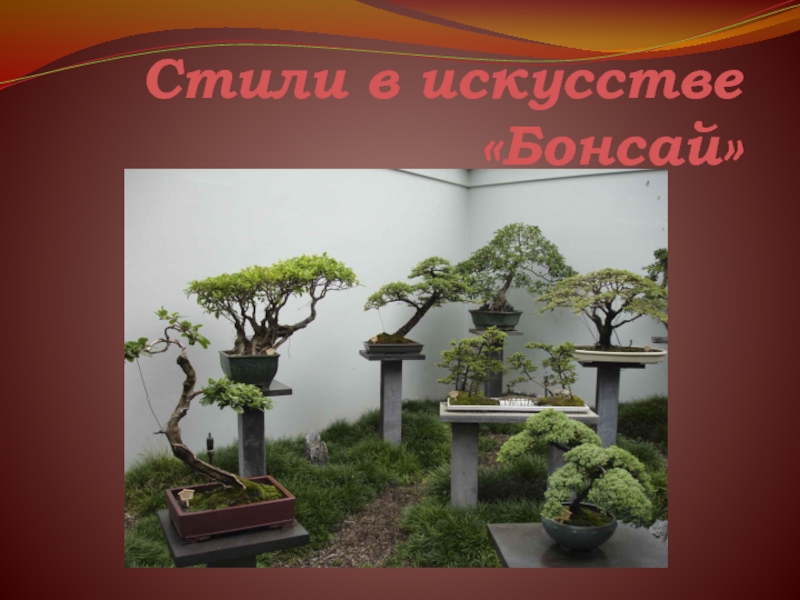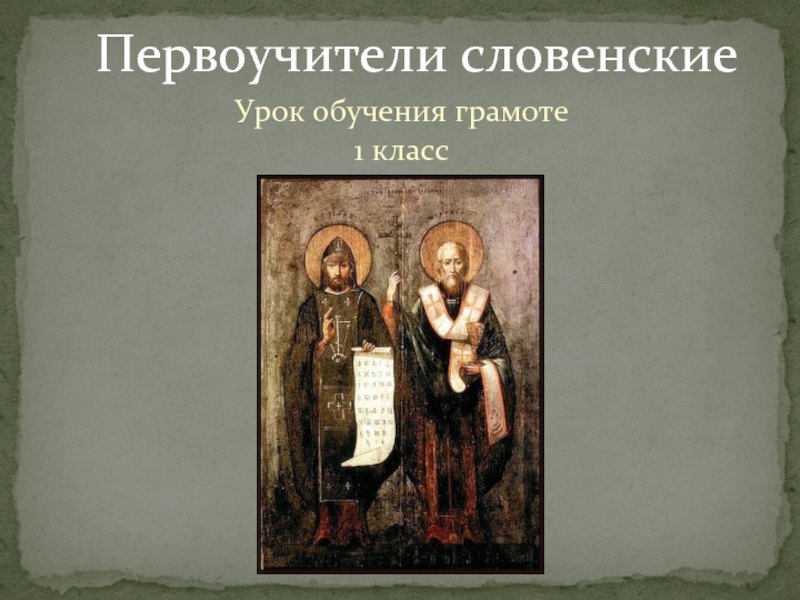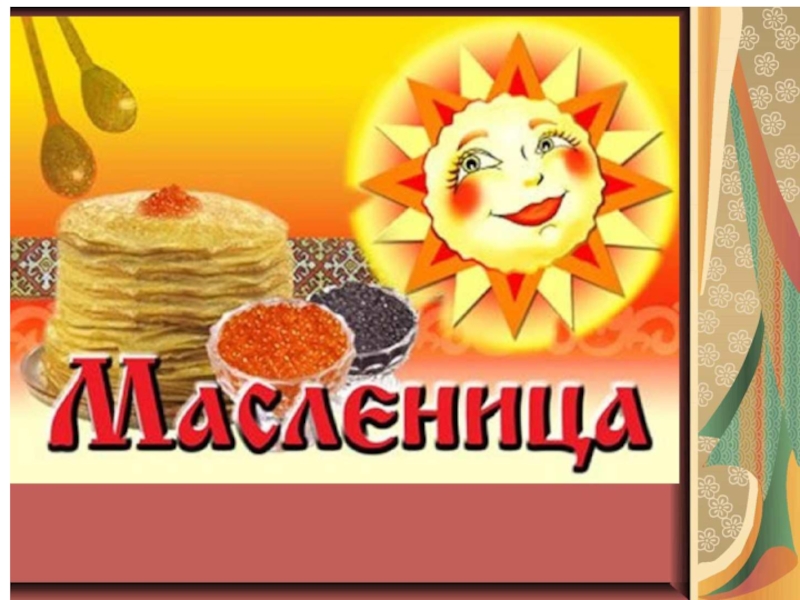- Главная
- Разное
- Дизайн
- Бизнес и предпринимательство
- Аналитика
- Образование
- Развлечения
- Красота и здоровье
- Финансы
- Государство
- Путешествия
- Спорт
- Недвижимость
- Армия
- Графика
- Культурология
- Еда и кулинария
- Лингвистика
- Английский язык
- Астрономия
- Алгебра
- Биология
- География
- Детские презентации
- Информатика
- История
- Литература
- Маркетинг
- Математика
- Медицина
- Менеджмент
- Музыка
- МХК
- Немецкий язык
- ОБЖ
- Обществознание
- Окружающий мир
- Педагогика
- Русский язык
- Технология
- Физика
- Философия
- Химия
- Шаблоны, картинки для презентаций
- Экология
- Экономика
- Юриспруденция
German Customs and Traditions презентация
Содержание
- 1. German Customs and Traditions
- 2. German Art The area of modern Germany
- 3. Medieval German Sculpture
- 4. 1930 German Art Deco Postcard Lady with Flowers
- 5. German Music Forms of German-language music include
- 6. German Music Genres
- 7. German Literature Medieval German literature refers to literature written in
- 8. German Literature
- 9. German Theater No country has as many
- 10. The Ekhof Theatre
- 11. German Dance German dance is an example
- 12. German Dance
- 13. German Film The history of cinema in
- 14. Lola Rennt (German Film)
- 15. Fragen 1.) What is the name of
- 16. Antworten 1.) a 2.) c
- 17. Sites http://en.wikipedia.org/wiki/German_art http://en.wikipedia.org/wiki/Music_of_Germany http://en.wikipedia.org/wiki/German_literature http://www.dw-world.de/dw/article/0,,3871070,00.html http://en.wikipedia.org/wiki/Schuhplattler
Слайд 2German Art
The area of modern Germany is rich in finds of
prehistoric art, including the Venus of Hohle Fels. The spectacular finds of Bronze Age golden hats are centered on Germany, as was the "central" form of Urnfield culture, and Hallstatt culture.
The court of the Holy Roman Emperor, then based in Prague, played an important part in forming the International Gothic style in the late 14th century. The style was spread around the wealthy cities of Northern Germany by artists such Conrad von Soest in Westphalia and Meister Bertram in Hamburg, and later Stefan Lochner in Cologne.
The court of the Holy Roman Emperor, then based in Prague, played an important part in forming the International Gothic style in the late 14th century. The style was spread around the wealthy cities of Northern Germany by artists such Conrad von Soest in Westphalia and Meister Bertram in Hamburg, and later Stefan Lochner in Cologne.
Слайд 5German Music
Forms of German-language music include Neue Deutsche Welle (NDW), Krautrock,
Hamburger Schule, Volksmusik, Classical, German hip hop, trance, Schlager, Neue Deutsche Härte (NDH) and diverse varieties of folk music, such as Waltz and Medieval metal.
Medieval metal is a subgenre of folk metal that blends hard rock or heavy metal music with medieval folk music. Medieval metal is mostly restricted to Germany where it is known as Mittelalter-Metal or Mittelalter-Rock.
Krautrock is a generic name for the experimental music scenes that appeared in Germany in the late 1960s and gained popularity throughout the 1970s, especially in Britain.
Medieval metal is a subgenre of folk metal that blends hard rock or heavy metal music with medieval folk music. Medieval metal is mostly restricted to Germany where it is known as Mittelalter-Metal or Mittelalter-Rock.
Krautrock is a generic name for the experimental music scenes that appeared in Germany in the late 1960s and gained popularity throughout the 1970s, especially in Britain.
Слайд 7German Literature
Medieval German literature refers to literature written in Germany, stretching from the Carolingian dynasty;
various dates have been given for the end of the German literary Middle Ages, the Reformation (1517) being the last possible cut-off point.
The Old High German period is reckoned to run until about the mid-11th century, though the boundary to Early Middle High German (second half of the 11th century) is not clear-cut.
The most famous work in OHG is the Hildebrandslied, a short piece of Germanic alliterative heroic verse which besides the Muspilli is the sole survivor of what must have been a vast oral tradition.
Sturm und Drang (the conventional translation is "Storm and Stress"; a more literal translation, however, might be storm and urge, storm and longing, or storm and impulse) is the name of a movement in German literature and music taking place from the late 1760s through the early 1780s.
The Old High German period is reckoned to run until about the mid-11th century, though the boundary to Early Middle High German (second half of the 11th century) is not clear-cut.
The most famous work in OHG is the Hildebrandslied, a short piece of Germanic alliterative heroic verse which besides the Muspilli is the sole survivor of what must have been a vast oral tradition.
Sturm und Drang (the conventional translation is "Storm and Stress"; a more literal translation, however, might be storm and urge, storm and longing, or storm and impulse) is the name of a movement in German literature and music taking place from the late 1760s through the early 1780s.
Слайд 9German Theater
No country has as many publicly-funded theaters as Germany. Some
150 of them receive government funding of some sort.
In addition, Germany has some 280 private theaters of varying size that show different types of work, with different history and traditions. Some 35 million theater-goers attend an annual total of around 110,000 theater performances, as well as some 7,000 concerts each year.
Germany’s tiniest theater is the Theader in Freinsheim in the state of Rhineland-Palatinate. The stage has room for just four actors; the house can hold up to 20 audience members.
Germany has some 40 festivals, around 150 theaters and other stages that have no ensemble attached to them, and about 100 touring troupes without a fixed stage. On top of that, there are countless unaffiliated theater troupes.
In addition, Germany has some 280 private theaters of varying size that show different types of work, with different history and traditions. Some 35 million theater-goers attend an annual total of around 110,000 theater performances, as well as some 7,000 concerts each year.
Germany’s tiniest theater is the Theader in Freinsheim in the state of Rhineland-Palatinate. The stage has room for just four actors; the house can hold up to 20 audience members.
Germany has some 40 festivals, around 150 theaters and other stages that have no ensemble attached to them, and about 100 touring troupes without a fixed stage. On top of that, there are countless unaffiliated theater troupes.
Слайд 11German Dance
German dance is an example of the exchange and the
relationship among the Courtly Dance, the social dance, and the folk dance.
It has its origins in the Allemande (French for "German").
This was a dance popular from the 16th to the 18th centuries, consisting of a calm part in 4/4 time followed by a quick part in triple time.
The Schuhplattler is a traditional Austro-Bavarian folk dance evolved from the Ländler.
The origins of this social dance are found in an early courtship display (Balztanz). Such a dance was described in 1050 by a monk ofTegernsee Abbey in the knightly poem Ruodlieb, wherein similar postures and movements of the Schuhplatter are depicted.
It has its origins in the Allemande (French for "German").
This was a dance popular from the 16th to the 18th centuries, consisting of a calm part in 4/4 time followed by a quick part in triple time.
The Schuhplattler is a traditional Austro-Bavarian folk dance evolved from the Ländler.
The origins of this social dance are found in an early courtship display (Balztanz). Such a dance was described in 1050 by a monk ofTegernsee Abbey in the knightly poem Ruodlieb, wherein similar postures and movements of the Schuhplatter are depicted.
Слайд 13German Film
The history of cinema in Germany can be traced back
to the year of the medium's birth. On November 1, 1895 Max Skladanowsky and his brother Emil demonstrated their self-inventedfilm projector the Bioscop at the Wintergarten music hall in Berlin.
In the period immediately following World War I, the film industry boomed, helped by the 1920s German inflation.
Expressionist movies relied heavily on symbolism and artistic imagery rather than starkrealism to tell their stories.
In the late 1950s, the growth in cinema attendance of the preceding decade first stagnated and then went into freefall throughout the 1960s. By 1969 West German cinema attendance at 172.2 million visits per year was less than a quarter of its 1956 post-war peak.
In the period immediately following World War I, the film industry boomed, helped by the 1920s German inflation.
Expressionist movies relied heavily on symbolism and artistic imagery rather than starkrealism to tell their stories.
In the late 1950s, the growth in cinema attendance of the preceding decade first stagnated and then went into freefall throughout the 1960s. By 1969 West German cinema attendance at 172.2 million visits per year was less than a quarter of its 1956 post-war peak.
Слайд 15Fragen
1.) What is the name of the prehistoric art found in
Germany?
a.) Venus of Hohle Fels
b.) Lola of Hamburg
c.) Bob
2.)Which music genre combines Metal and Medieval Folk music?
a.) Krautrock
b.) Schlager
c.) Medieval Metal
a.) Venus of Hohle Fels
b.) Lola of Hamburg
c.) Bob
2.)Which music genre combines Metal and Medieval Folk music?
a.) Krautrock
b.) Schlager
c.) Medieval Metal
